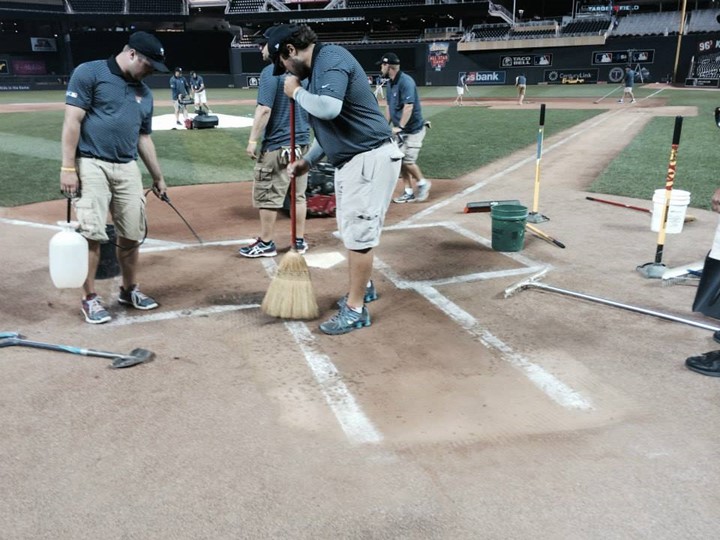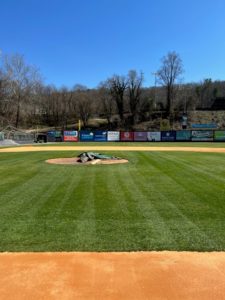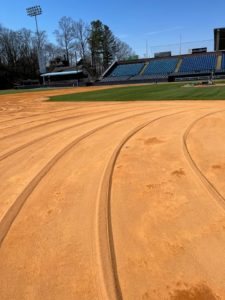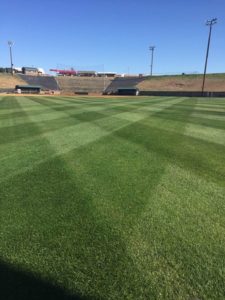By Steve Peeler, CSFM
Sports facilities come in all different levels of play, size and types of events that occur. Regardless of level of play, type of sport played or other events, there is one thing that they all have in common and that is player safety. Safety is the number one priority when it comes to playing surfaces – both natural grass and synthetic. Each sport has areas that are more sensitive in protecting players and participants. Maintaining these areas requires different maintenance practices, moisture management, firmness and playability.
First, the playing surface must be consistently level and true so the best playing conditions can be maintained while making the games more enjoyable for all involved. At the professional level, playing surface management is more important than ever before. Even at the recreational level of play, playing surfaces have become the focus of liability lawsuits.
Surface runoff and internal drainage is the first ingredient required to pass the safety test of a playing surface. Traveling sports teams pay a lot of money and often travel great distances to compete. Therefore, fields must be ready to play immediately after – or sometimes during – inclement conditions. It is also in the best interest of promoters that sponsor the events to make sure drainage is the number one priority, as they don’t want to have to reschedule events and refund money back to teams because they can’t play.
Should a playing field lack the proper drainage, a rain event that occurred prior to a sporting event may take hours or days to return to safe playing conditions. As an industry standard, most college and professional fields throughout the United States must have an elaborate drainage system and, in some instances, mechanical assistance in making sure fields return to safe play in a very short timeframe.
Playing surface
Once an adequate drainage system can be confirmed, the next most important area of concern is the playing surface itself. Surfaces must have proper slope so runoff can be accomplished to 100% certainty. Furthermore, all playing surfaces should be without large undulations, ponding water, depressions or irregularity for the safety of the athletes. Large stadium venues must take the proper steps to conserve the integrity of the turf and grade of the playing field. Even when protection has been exercised and precautions in place, the surface can still be damaged with irregular growth patterns, stunted growth, and diseases. Once the playing surface has been transformed back into its natural state, unsafe conditions still may be present.
Protective covers and foot traffic in localized areas can result in compaction while reducing air and water within the root zone. Surfaces become slippery and hazardous for all athletes and participants once compaction or overuse of the playing surface occurs. Typically, there is very little time between non-sporting events (concerts, conventions, etc.) and actual sporting events to conduct cultural practices to assist in the improvement and cure of these conditions.
Sure footing on the playing surface is a must when it comes to all levels of play. Excessive moisture within the thatch layer can cause injury, which could be long term and affect the athletes. Moisture content can be controlled with proper drainage, maintaining thatch laying at ½-inch or less, aeration, vertical mowing and proper irrigation practices. Nevertheless, proper soil and infiltration rate is required as a part of maintaining optimum moisture levels.
Cultural practices such as topdressing with specified sand, aeration and vertical mowing will increase the playability of the surface and are required at all levels in coordination with rootzone mixes. Improper sieve sizes within the rootzone will increase moisture-holding capabilities to a point that surfaces are soft, unstable, and, in some cases, damaging to the surface with regular maintenance equipment. When this occurs, renovation should be a consideration.
Firmness of either a natural grass, synthetic turf or infield skin surface becomes an issue if Gmax is rated at 200 or higher. Surfaces that become too hard can also lead to injury, as well as affect ball roll, ball spin, and ball bounce. Infield skin areas are specifically sensitive to firmness and ball reaction. Directional rotation can cause a ball to react differently on ball bounce and stay down, come up, or move rapidly to one side of the other. Moisture management is very important so consistency can be expected on every play as much as possible. Once the athletes become comfortable with ball bounce and reaction, it is easier to execute plays and perform.
Lips, elevation changes, and depressions can also cause ball roll to be affected in a negative way. Injuries have occurred because of the sudden directional change, as the players are on a fixed path to catch or stop a ball in play. Player reaction times are sometimes slower than the ball’s directional change once a play has begun. Firmness and optimum moisture management are key components in producing a standard playing surface.
Maintenance requirements
Maintaining a sports facility requires equipment and personnel to be successful. As our industry evolves, new technology has reduced the amount of labor required. Mechatronics, robotics and improved cultural practices have allowed many facilities to save labor cost while increasing productivity. Having equipment that meets and exceeds the level of maintenance required is highly recommend. Maintaining that equipment will determine future success at your facility. Although most facilities don’t have Major League budgets, practices can sometimes be performed with use of creativity and imagination. Having a big-league surface on a Little League budget can be accomplished with additional time spent on details. Mowing, grooming, aeration, topdressing and fertilization must be performed with the proper equipment for success and health of the turfgrass.
Inspection and auditing of the irrigation system should take place often to ensure full coverage is being accomplished and able to meet the needs of the playing field. All systems require slight adjustments throughout the season, so it is recommended to perform inspection and auditing once per month to certify that the system is operating correctly. Equal distribution over the entire area being irrigated can be confirmed by conducting a simple catch can test.
Steve Peeler, CSFM, is senior field manager for the Atlanta Braves.





